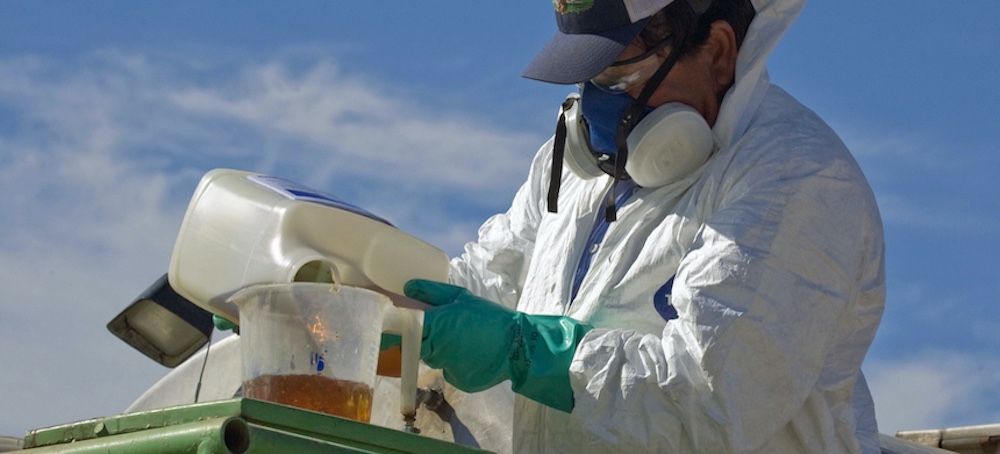CDC Finds Weed Killer, Roundup Tied to Cancer in Over 80% of US Urine Samples
Carey Gillam The New Lede A worker mixes pesticides, which will be sprayed on a field. (photo: David Bacon/Report Digital-REA/Redux)
A worker mixes pesticides, which will be sprayed on a field. (photo: David Bacon/Report Digital-REA/Redux)
The June 30 report by a unit of the Centers for Disease Control and Prevention (CDC) found that out of 2,310 urine samples collected, 1,885 were laced with detectable traces of glyphosate, the active ingredient in herbicides sold around the world, including the widely used Roundup brand.
The new data was released as part of the National Health and Nutrition Examination Survey (NHANES), which relies on a series of ongoing studies to evaluate the health and nutritional status of adults and children in the United States. NHANES research is typically highly valued by scientists because the sampling is designed to be representative of the US population.
NHANES says in order to produce reliable statistics, it “over-samples” African Americans, Hispanics and people 60 years old and older.
Also, a CDC spokesperson said the agency’s National Center for Environmental Health (NCEH) “is working on analyzing glyphosate” through additional data.
Academics and private researchers have been noting high levels of the herbicide glyphosate in analyses of human urine samples for years. But the CDC has only recently started examining the extent of human exposure to glyphosate in the United States, and its work comes at a time of mounting concerns and controversy over how pesticides in food and water impact human and environmental health.
“I expect that the realization that most of us have glyphosate in our urine will be disturbing to many people,” said Lianne Sheppard, professor at the University of Washington’s department of environmental and occupational health sciences. “Now from this NHANES analysis we know that a large fraction of the population has it in urine. Many people will be thinking about whether that includes them.”
Sheppard co-authored a 2019 analysis that found glyphosate exposure increases the risk of non-Hodgkin lymphoma, and also co-authored a 2019 scientific paper that reviewed 19 studies documenting glyphosate in human urine.
That latter paper concluded that more robust research was needed to “fully understand the extent of exposure overall and in vulnerable populations such as children.”
The CDC work now is a “huge step” toward addressing that need, Sheppard said.
Found in baby food
Both the amount and prevalence of glyphosate found in human urine has been rising steadily since the 1990s when Monsanto Co. introduced genetically engineered crops designed to be sprayed directly with Roundup, according to research published in 2017 by University of California San Diego School of Medicine researchers.
Paul Mills, the lead researcher of that study, said at the time there was “an urgent need” for a thorough examination of the impact on human health from glyphosate in foods people commonly consume.
More than 200 million pounds of glyphosate are used annually by US farmers on their fields. The weedkiller is sprayed directly over genetically engineered crops such as corn and soybeans, and also over non-genetically engineered crops such as wheat and oats as a desiccant to dry crops out prior to harvest. Many farmers also use it on fields before the growing season, including spinach growers and almond producers. It is considered the most widely used herbicide in history.
Residues of glyphosate have been documented in an array of popular foods made with crops sprayed with glyphosate, including baby food. The primary route of exposure for children is through the diet.
Roughly 87% of children represented in the CDC study had the pesticide in their urine, according to a population-weighted analysis by the Environmental Working Group (EWG) research organization. In 2019, EWG and several food companies called for a ban on glyphosate as a desiccant, saying “Americans’ widespread exposure to glyphosate is of growing concern, particularly in the context of children’s health, because of the potential risk of cancer.”
Monsanto, and its owner Bayer AG, maintain that glyphosate and Roundup products are safe and that residues in food and in human urine are not a health risk.
But many researchers disagree and say there is a large body of evidence linking glyphosate exposure to disease. The International Agency for Research on Cancer, a unit of the World Health Organization, classified glyphosate as a probable human carcinogen in 2015.
The US Environmental Protection Agency (EPA) has taken the opposite stance, classifying glyphosate as not likely to be carcinogenic. But last month the 9th U.S. Circuit Court of Appeals issued an opinion vacating the agency’s safety determination and ordering the agency to give “further consideration” to evidence of glyphosate risks.
Research indicates the chemical is also tied to other health problems, including liver disease.
“People of all ages should be concerned, but I’m particularly concerned for children,” said Phil Landrigan, who worked for years at the CDC and the EPA and now directs the Program for Global Public Health and the Common Good at Boston College.
“Children are more heavily exposed to pesticides than adults because pound-for-pound they drink more water, eat more food and breathe more air,” Landrigan said. “Also, children have many years of future life when they can develop diseases with long incubation periods such as cancer. This is particularly a concern with the herbicide, glyphosate.”
Cynthia Curl, Boise State University assistant professor of community and environmental health, said it was “obviously concerning” that a large percentage of the U.S. population is exposed to glyphosate, but said it is still unclear how that translates to human health.
“We have a critical need for more epidemiological research,” Curl said. “I will say that I am very glad to see NHANES including glyphosate measurements, and that in and of itself is an important step forward.”



